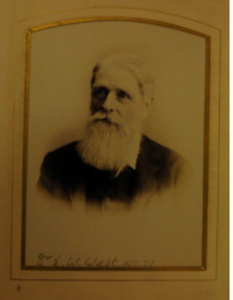West Papers now live on Archives Hub
We are happy to announce that the personal papers of the West brothers – Edward William, Arthur Anderson, Henry, Clement and Walter – have now been catalogued and are available for readers to access on Archives Hub.
The collection contains seven leather bound portfolios of works that were created during the brother’s time in the Maharashtra region of India in the mid to late 1800s. All five brothers worked as railway engineers, predominantly on the Bhor Ghat mountain passage with Edward William West becoming Chief Engineer of the Great Indian Peninsula Railway (GIPR) in 1852.

During his time in India, Edward documented rock-cut caves and temples in the Maharashtra region. Arthur later joined his brother in November 1849 when working as a railway surveyor for the GIPR with Henry joining in 1851. Following the completion of the line between Mumbai to Janna in 1853, Henry started systematically documenting the Kanheri Caves in 1870 alongside Walter West.
The main focus of the collection is around the Kanheri Caves; a group of over 109 rock cut temples located in what is today the Sanjay Gandhi National Park on the western outskirts of Mumbai. The brothers studied these caves over several decades, returning to the site many times to check and amend measurements, locations, and expand their interpretation of the site. The remainder of the collection covers several other sites such as Ajanta, Ellora and Daulatabad.

The result of this detailed work can be seen within the collection with portfolios containing notes, topographical drawings, papers, maps, engravings, rubbings and floor plans. Before the formation of the Archaeological Survey of India, the work of engineers such as the West brothers was critical in helping to form a meticulous bank of knowledge of historical sites across British India.


The collection was donated to the Society by the widow of a former Fellow, James Burgess, in 1916. In the course of his work as an Archaeologist, Burgess had contacted Arthur West about using the portfolios for a proposed project that never came to fruition. Correspondence within the collection illustrates that Arthur sent the portfolios by registered post to Burgess in 1906.

We would like to thank one of our former Volunteers, Lily Colgan, for her work in cataloguing this collection. Lily wrote a previous blog post around her experiences when cataloguing the collection which can be found here: https://royalasiaticsociety.org/celebrating-our-achievements/
Professor Roger Long Lecture:
On Tuesday evening (20th July), the Society welcomed Professor Roger D. Long who did a lecture on ‘Liaquat Ali Khan, Jinnah’s “Right Hand”: Politics and the Creation of Pakistan, 1895-1947’.
Professor Long spoke about the life of Liaquat Ali Khan, the first Prime Minister of Pakistan, in the years before 1947. This included an examination of Liaquat’s background and career, his education at Aligarh and Oxford, as well as his devotion to the ideals of Sir Syed Ahmad Khan, Iqbal and Jinnah.
The lecture was well attended and is now available to view on the Society’s YouTube page.
